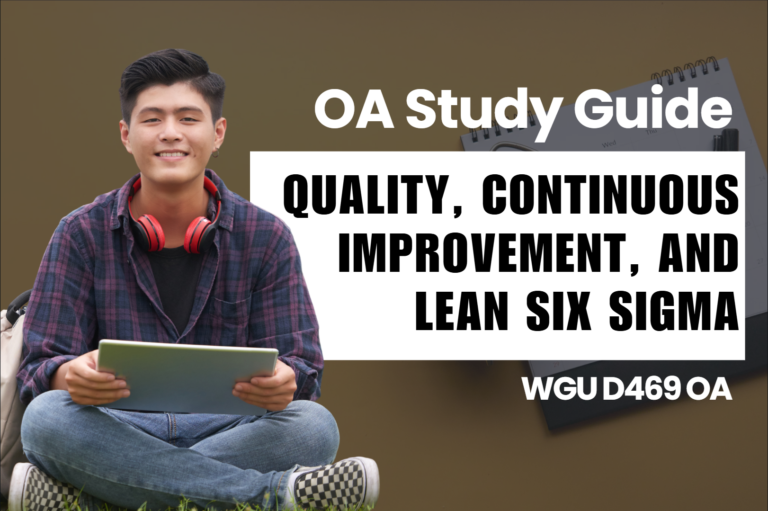Welcome to a deep dive into the fascinating world of Critical Thinking: Reason and Evidence D265 at WGU! The course is intended to provide you with vital things such as the ability to think logically, assess arguments, and make progressive decisions. This is an introductory course to critical thinking and formal logic where the student will be given or may choose to select different newspaper articles that will challenge him or her to analyze exposes that are rather convincing but contain fallacies in arguments regularly witnessed, analyzed, and read. But that is all about the working of the brain with the aim of reaching the best decisions that will be defendable in the future.
Here are some of the concepts that are going to be discussed in this course; analyzing arguments, recognizing prejudices, and the use of proofs in substantiation among others. This is not just another class; It is actually a journey that helps to develop the competency that will help you weigh information critically in your general academic and working experience. I therefore guarantee you that by the end of this course, you stand to benefit immensely in your ability to solve most problems with precision.
...
An Overview of What to Expect in WGU D265 📖
Critical Thinking: Reason and Evidence D265 is a course that aims at changing how you look at information, argument, and evidence. Throughout this course, you will be learning core components that will enable you to critically assess reasons and evidence. This course is divided into five major areas, each of which addresses key components of critical thinking. Starting with the essentials of an argument, you will start disassembling arguments, and assessing the quality of the evidence provided by both sides of the argument. Here you are going to get lessons intending to make you grasp what constitutes a good argument and have the ability to identify flaws in reasoning.
Further in this process, you will be introduced to the concept of source evaluation which helps to assess where your information is from and if it should be trusted. In this section, we will learn how to ask critical questions about the sources and the authors who produced them and in this way estimate the sources. The next significant aspect that is touched on is bias—how one’s bias, or an outside bias, can skew case construction and evidence presentation. It is always crucial to learn and distinguish the bias to become a better critical thinker, and this section sets the platform to assist one in eradicating the bias from his or her reasoning process.
It also heavily focuses on preparing the student for making claims and supporting them with evidence. In the final sections, you’ll be able to make assertions on your individual and back them up with reliable source materials. The course is self-taught so the user can move from one section to another at his or her own pace, they can go slow or fast depending on their learning ability. You should plan to spend about 30-40 hours on this course if the concepts are new to you. Throughout, they will be reading, watching videos, completing quizzes, and sample practice tests that are meant to enhance the learning process and to prepare them for the end of the course assessment.
Study Guide for WGU D265 OA📝
Mastering Critical Thinking: Reason and Evidence D265 requires a strategic approach. Here’s a step-by-step guide that will help you efficiently navigate through the course and ensure you’re well-prepared for the final assessment.
Step 1: Read the Textbook Provided by WGU
The very first thing that you have to do is acquaint yourself with the material found in the textbook furnished by WGU. This book is your main textbook for this class and all the information you would require for an understanding of the subject matter is in this book. It is better not to try to just read through it quickly; use the precious time to actually pay attention. Critical sections are emphasized, remarks are made, and the scholar must be in a position to understand each chapter before proceeding to the next one. To facilitate you to understand better, key terms from D265 have been listed in the Key Terms from D265 document. It will be a great handy when it comes to memorizing the terminology used in the course because of the outlined format. That way, when the course content advances to a concept you do not fully understand, at least you recognize the terms that are important in the idea.
- Textbook: Go to the Student Portal of WGU > Log onto your profile > Go to the D265 module page > Click on the “Go to course materials”
Step 2: Watch the Lecture Videos, Cohorts, and Podcasts
After you have set the foundation with the textbook, increase your comprehension through the use of lecture videos, cohorts, and podcasts. The multimedia resources offer a distinct view and elaboration of concepts, which can assist clarify topics that were problematic in the textbook. It is also easier to learn if there are real-life scenarios explained in the videos which could be quite impractical to explain in a text or in black and white. Ensure that you take notes during these sessions since you will need the notes when you’re-studying. Included at the end of the cohorts and each podcast is the expert’s commentary, which enhances your knowledge and provides a perspective on how the concepts play out in the real world.
- Lecture Videos/Cohorts/ Podcasts: Go to the Student Portal of WGU > Log onto your profile > Go to the D265 module page > Click on the “Course Search” > Open the links to “D265 Videos (LR)”, “Think Like a Nurse podcast”, “D265: Think Like a Teacher podcast” and “D265 Video Library”
Step 3: Attempt the Practice Questions
This is the final part of the learning process; now that you have digested the core content, it is time to see how much-retained knowledge you actually have. Solve the practice questions given at the end of each lesson from the course. These are the set questions for your review to ensure that you grasp every topic and most importantly identify areas that require further study. Do not just skim over them, usually read each question very well and think before you check the solution. By attempting these questions, the understanding of the matter will become even denser, and at the same time, one will get used to the kind of questions that will be asked in the assessments. If you encounter particular questions that you do not understand, jot them down and review that section in the textbook or from the videos.
- Practice questions: Go to the Student Portal of WGU > Log onto your profile > Go to the D265 module page > Click on the “Course Search” > Open “D265 Video Library” > Scroll down to find the practice questions videos
Step 4: Do the Pre-Assessment (Pre-A)
After you master all the material, after each section, take the Pre-Assessment (Pre-A). It is significant to stress that Pre-A is an important stage in your study schedule because it resembles the exam itself. It will also explain to you how ready you are and areas that will require reinforcement. Approach this assessment as a real thing; do this test in a quiet area, and without spending too much time on it, just like the real exam settings. Consequently, it will also be relevant to go back to the results of the Pre-A and briefly analyze them. Any areas of the test you performed poorly in should be given more attention, as well as a re-study of the related topics.
Step 5: Do the Objective Assessment (OA)
The last process which has to be completed is the Objective Assessment (OA). By now, you should be ready, given you have worked through the textbook, watched the videos, solved questions, and made the Pre-A. Go to the OA confidently aware that you have trimmed down your study plan to the best and most effective study plan. Just like most tests and examinations, do not spend much time on a given question in the course of doing the assessment. Reliability in the preparation you’ve done and then go out there and do your best.
...
External Resources to Study📂
To supplement your studies in Critical Thinking: Reason and Evidence D265, there are several free resources available online that can help you grasp difficult concepts and reinforce your understanding. Below are some highly recommended external resources that you can explore:
TeachPhilosophy YouTube Channel
- TeachPhilosophy Playlist
- This YouTube playlist is an excellent resource for visual learners. It covers a wide range of critical thinking topics, with a particular focus on analyzing arguments and evaluating evidence. The videos are well-structured and provide clear explanations, making complex concepts more accessible. It’s a perfect supplement to the textbook material, offering different perspectives and examples to solidify your understanding.
Supporting Guide for Learning Fallacies (YouTube)
- Learning Fallacies Video
- Understanding fallacies is crucial for critical thinking, and this video is a great resource to help you learn and identify common fallacies in arguments. The video is concise and easy to follow, making it a quick yet effective way to grasp this important topic. You can watch it multiple times to reinforce your knowledge as you prepare for the assessments.
Quizlet Flashcards
- Quizlet #1
- Quizlet #2
- Quizlet flashcards are a great way to memorize key terms and concepts for the D265 course. These two sets are specifically tailored to this course and include a variety of terms and definitions that you’ll need to know. Using flashcards is an effective method for active recall, helping you retain the information better as you review.
Khan Academy: Critical Thinking Course
- Khan Academy Course
- Khan Academy offers a free course on critical thinking that aligns well with the D265 material. It covers essential topics such as evaluating arguments, understanding evidence, and recognizing bias. The course includes both video lessons and practice exercises, making it a comprehensive resource to enhance your learning experience.
These resources will provide you with diverse tools to tackle the course content from different angles, helping you to better understand and apply critical thinking concepts in your assessments.
...
How to Prepare for the D265 OA 👨🏻🏫
Preparing for the Objective Assessment (OA) in Critical Thinking: Reason and Evidence D265 can seem daunting, but with a focused approach and the right strategies, you can excel. Here are some key tips and advice to help you navigate through the preparation process and ensure you’re ready for the final test.
- Pay Close Attention to Section 4 – Fallacies
One of the most critical sections in your course material is Section 4, which covers fallacies. Understanding fallacies is essential because they play a significant role in the OA. You’ll need to identify and differentiate between various fallacies, such as genetic fallacy, red herring, straw figure, and ad hominem attack. These are commonly tested, and being able to recognize them in examples is crucial. As you study this section, take thorough notes, and revisit this material frequently to ensure that these concepts are solidified in your memory.
- Utilize the Comprehensive Practice Tests
Two practice tests are part of your course; they are the best samples you can use when preparing for the exam. The first one is in section five of the course contents and includes a sample practice test, while the second one is known as the Pre-Assessment (Pre-A). This means that it must involve tests that replicate the OA to ensure that one has an understanding of what to expect. After both, then you should read your answers thoroughly starting with the erroneous part to realize your weakness. In case you still want to take more practice, don’t let your course instructor deceive you – they are always ready to assist by giving you more practice resources.
- Take Detailed Notes and Focus on Vocabulary
While going through the chapters, take it personally to write notes on this and that, on this and that. Thus, focus on the specified words and terms that you might need to go again over in the assessment. This will assist you during revision and will also assist in making sure that you are not likely to miss vital aspects. The following terms will be useful when reading the proposed texts: critical thinking, proposition, inference, deductive reasoning, and inductive reasoning. Therefore, it won’t be wrong on my part to assert that a good understanding of these definitions could help one in the OA.
- Understand Biases and Thinking Systems
The OA lays a special emphasis on breaking down and recognizing bias as well as thinking systems. These biases include confirmation bias, cognitive bias, anchoring, and the availability heuristics; you must know about them. Also, identify between heuristics (quick unconscious processes) and the mode of operation (logical and careful processes). Learning these concepts will assist you in solutions, proposals, and questions where identification and evaluation of biases are needed.
- Master Argument Structures and Formulas
Knowing how to analyze argument structures is another critical aspect of the OA. Familiarize yourself with the “formulas” used to determine argument structures, such as denying the antecedent, affirming the antecedent, and denying the consequent. Understanding these structures will allow you to break down arguments and assess their validity effectively. This is a skill that is not only useful for the OA but also for critical thinking in general.
- The OA is Similar to the PA—Leverage This!
Many students find that the OA is quite similar to the Pre-Assessment (PA). Use this to your advantage by thoroughly preparing for the PA, as it will give you a strong indication of what to expect in the OA. Treat the PA as a full-fledged practice run, and address any weaknesses you identify before taking the OA.
By following these tips and focusing on the key areas highlighted, you’ll be well-equipped to tackle the OA with confidence. Remember, thorough preparation and a solid understanding of the material are the keys to success.
...
WGU D265 FAQ ❓
Q: What is the most challenging part of the D265 course?
A: Many students find that understanding and identifying different types of fallacies can be particularly challenging. Fallacies are a key focus in both the course material and the Objective Assessment (OA), so it’s crucial to spend extra time mastering these concepts. The vocabulary and the different types of biases can also be tricky, so it’s important to review them thoroughly.
Q: How similar is the OA to the Pre-Assessment (PA)?
A: As observed before, the type of questions and content of the OA is almost the same as the PA. By doing well on the PA, one can be assured that he or she is ready to tackle the OA because they are alike. Although you do not get markings for the PA, it is crucial to go over places where you had an issue so that for the final assessment you are prepared.
Q: How much time should I allocate to study for this course?
A: Specifically, at present, the course is flexible, thus learners with no previous experience or knowledge spend 30-40 hours on the course content. Also, it is advisable to divide the material into different periods and devote certain days a week to studying in order not to get exhausted and to assimilate all the information accurately.
Q: What are the best resources to use outside of the WGU materials?
A: While the WGU course materials are comprehensive, supplementing your studies with external resources can be very helpful. YouTube channels like TeachPhilosophy, flashcards on Quizlet, and the Khan Academy’s critical thinking course are great free resources that can provide additional explanations and practice.
Q: How can I best prepare for the fallacies section?
A: The fallacies section is critical, and the best way to prepare is by understanding and memorizing the different types of fallacies. Use resources like the course textbook, your notes, and external videos to review each fallacy. Practice by identifying fallacies in sample arguments or in everyday situations.
...
Conclusion📄
Wrapping up your journey through Critical Thinking: In Reason and Evidence D265 at WGU, it becomes easy to see that this is not just another course that one needs to complete to fulfill the requirements but it is a chance to build skills that are essential in everyday life. By now, you should have an understanding of how to evaluate arguments, identify sources of bias, and appreciate the concept of evidence in arriving at reasonable conclusions. To stress, the effective strategies for this course are the comprehension of the foundational ideas, preparation, and perseverance.






